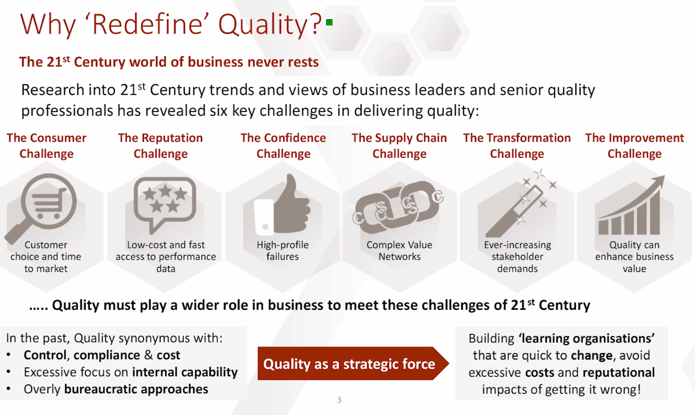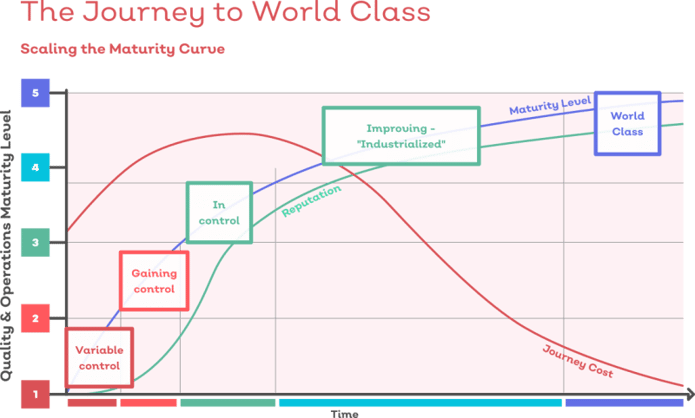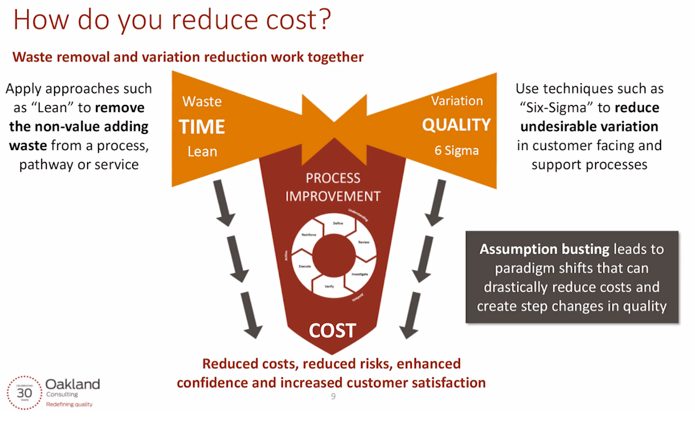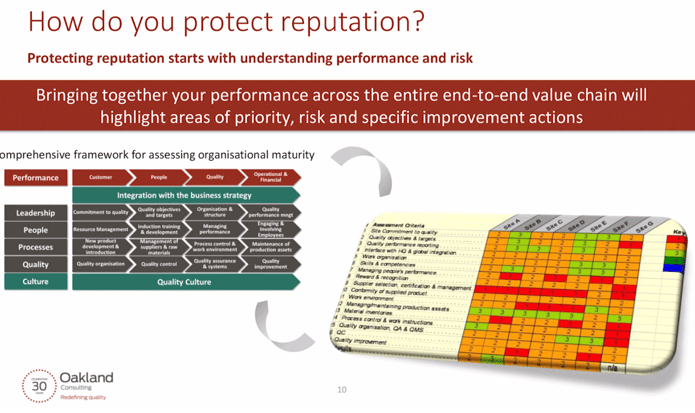Want to contribute to this article?
It's no secret – the role of quality is changing. You only need to read some of these case studies to see some of the amazing projects. And you probably have your own experiences you can share. (Join our Meetups to share your stories and challenges.)
During the EQMS User Group, John Oakland and Richard Corderoy discussed how the role of quality is changing and what quality professionals need to focus on.
Watch the video or read the transcript below.
[7 minute read + chance to earn 1 Hour CPD]
-
Speed1x
-
Quality360p

Thanks for reporting a problem. We'll attach technical data about this session to help us figure out the issue. Which of these best describes the problem?
Any other details or context?
Here is the transcript from the presentation:
About this presentation
We're here to pick up on one of the key points that came out from the Global Quality Trends Survey 2017. This is to discuss at what level do chief executives know that quality is really important? Of course they know it because their customer requires it and the regulator demands it. Deep down, while they know this is true, unfortunately they don't rate the tools and approaches the quality profession uses and don't always rate the quality people that run them.
Oakland Consulting has been here for a very long time now. However, we find ourselves increasingly focusing on how we can move the great-thinking, very mature approaches of the quality team and get them into the boardroom so that the people in the boardroom listen and take note of what's happening. Hopefully that will resonate.

I've spent the last 30 years of my life helping organisations to improve their performance. To get their quality right. On time. And at the right cost. That is the value triangle that we live in:
- Is this the right quality?
- Is it the right design?
- Have they made it right?
- Is the price right?
Car manufacturers have to make a profit out of this, otherwise they will not survive. This is what makes the world go around.
I started my career as a statistician, doing statistical process control. Of course, that's someone who wanted to be an accountant, but lacked the charisma.
| "Quality professionals can help organisations as a statistician, if you apply your thinking, your tools and techniques in the right way and in the right areas." |
Quality professionals can help organisations as a statistician, if you apply your thinking, your tools and techniques in the right way and in the right areas. If you start talking about distribution, it's going to be a big turn-off. And that's a challenge we all face in this space of quality, helping as professionals in the area.
I remember being at a conference not long ago, when the Quality Director of Axto stood up and said, "If you were to line up all of the quality managers in the world end-to-end, it probably would be a very good thing."
Why redefine 'quality'?
We don't come to this game with a very good reputation. One of my colleagues, a professor at Leeds University, Chi Wong, surveyed a series of general managers. He asked, "What do you think of quality people?"
| "We don't come to this game with a very good reputation." |
Their response was "We don't like them." It's not anything about what they do wrong. They just don't like them. Now that is a really significant burden for you to carry. What I'd like to do is to step out of your role and think, "How am I going to start dealing with these challenges I am faced with? And the fact that my chief executive probably doesn't want to see me in the lift. And if I did get 60 seconds in the lift, what sort of things would I talk to him about?"
The 21st-century world is very different and moving very fast. As we are sitting here now, someone out there is developing a new product. It has got to get out quickly because the competitors have bought it out; it probably won't work, but so what? And we'll probably send out an upgrade in a few more months or weeks anyway.
| "What quality really is at the heart of good business – it still remains the most important competitive weapon we have." |
What quality really is at the heart of good business – it still remains the most important competitive weapon we have. Putting the customer at the heart of everything we do, and meeting their needs time and time again in a consistent manner, is key. It's a simple concept, but meeting those requirements, more than ever now, things go wrong. Quality can be hard to attain; it can be hard to maintain and in large and complex organisations, it can be very easy to lose.
| "Quality can be hard to attain. It can be hard to maintain. And in large and complex organisations, it can be very easy to lose." |
If you fail to manage quality, not just the quality management system, but quality in general, there's going to be some big challenges for you. In the fast-moving world we live in, that will quickly damage your reputation. Your financial losses will be huge. And I don't need to remind you of all the scandals like horsemeat we hear about on a daily basis now.
We carried out some industry research, similar to the Global Quality Trends Survey 2017, which found that only 67% of leaders were engaged with quality. I'm actually surprised that 33% of quality managers say leadership are engaged!
In our survey, we interviewed business leaders and senior quality professionals. We discussed the challenges, change and uncertainty.

There were six key challenges:
1) The consumer challenge
If you go into Tesco, you can choose a huge variety of different brands. There's more consumer choice than ever before, and this is driven by time-to-market. We have to get the new product out to meet the challenges we're facing.
2) The reputation challenge
Performance data is readily available. You press a button and all the information is widely out there. It is low cost, fast access. Your customers can look and see how you're performing. You can see how your suppliers are performing. You are always on the cusp of your reputation going wrong.
3) The confidence challenge
Product recalls have increased by four and a half times in the last 25 years. Consumers have lower confidence in your brand and they start to not believe what you tell them.
4) The supply chain challenge
More than ever, there are complex value chain networks. Our research indicates that a supplier's ability to deliver on time and on cost is one of the most important risks to manage. Of these interviewees, 75% put their supply chain in the top three challenges.
I remember working with a company who introduced the set-top boxes for the tops of televisions/satellites for Sky Sports. Big brands are constantly putting pressure on suppliers to reduce their costs. A company like Paysys. They don't manufacture, they design the product and they get the parts manufactured in China. An example is when somebody sends a message from Sky and says they need to take some costs out of the box; that message goes down the supply chain. They decide to take out the capacitors – that piece of metal that sits in between the layers. This precious metal is made thinner and thinner and thinner.
Then when customers go to touch the box, they realise it's hot. Some even caught fire.
Sky don't like their boxes to catch fire. That created a huge problem in the electronics industry. That is the challenge quality professionals face. What's your role in alerting senior management? Can you have the conversation with senior management? You should have the authority to tell your company.
5) The transformational challenge
Failure is not just delivered. It is the way we manage change and deliver it to the eyes of the customer.
6) The improvement challenge
There are big opportunities to improve the business which are not being sufficiently employed. People like quality managers need to engage with the idea that there are three legs of your stool.
- Getting the organisation to set up the standards
- Setting up systems to meet the standards and audit them
- Improvement. For many quality professionals this is lost. Improvement is what their organisation is looking for but they keep falling off the stool. They need you to help them. There is no point shrugging your shoulders. That is not the message top management want to hear. Quality managers need to be playing a much wider role to meet the challenges of the business.
| "Quality managers need to be playing a much wider role to meet the challenges of the business." |
The perception of quality
Qualsys can engineer better services to you that provide you with better data and communication. But you need to step up to the challenge also. You may shoot the messenger. The worst thing that can happen to me is that I get thrown down the stairs and you never see me again. I have to tell you though that quality is synonymous with control, compliance and cost. It is associated with excessive focus on internal capability and overly bureaucratic processes.
| "Excessive focus on internal capability and overly bureaucratic processes." |
I do honestly get people saying to me, "It's rubbish, this job". I ask them, "Well, what are you going to do about it? Are you going to stand there like a rabbit in the headlights or are you going to do something about it?"
You have to become, and Qualsys have to help you, and Oakland have to help you to get into the boardroom, to build quality as a strategic force. This means we'll help you to build learning organisations that are quick to change, avoid excessive costs and reputational impacts of getting it wrong. In these three things, please note that I didn't mention quality.
| "Qualsys and Oakland can help you build quality as a strategic force." |
The Journey to 'world-class' quality and becoming a 'world-class' quality leader
I'm now going to take you on a journey. The journey that you're going on is one to a 'world-class organisation'. The only organisations that are going to survive in our view and succeed in the future are 'world-class organisations'.

Think about when you launch a new product. It may be a very mature company. But as soon as that new product comes out, the organisation can slip back down the curve. You can have your whole organisation described on that maturity curve. Organisations progress on this journey.
There is a curve which runs with that – the cost curve. Where are we with that cost? The cost goes up until your quality matures. If you have an arm on a robot and it doesn't work, the implications can be very expensive.
Maybe I'll need to go and talk to everyone at the bank. Maybe I'll have to take the wine off the shelf. Maybe that means that the hospital cannot do the heart operation that day when everyone's lined up to do it.
Failure costs a fortune. Getting up the curve takes a lot of investment as well. That is costing your business a lot of money.
| "Failure costs a fortune. Getting up the quality maturity curve takes a lot of investment as well." |
You can't get up that curve without having better processes, better systems, better people, training, development and so on. There's a need to progress. So as that journey progresses in maturity, at first the costs accumulate and then they decrease as quality matures.
| "Getting quality right brings cost down." |
There is a perception that you can't have quality and cost. This is wrong. When we have world-class maturity and high-performing organisations, we have low cost and high profit. Getting quality right brings the cost down. You have to believe this and show it.
Stakeholder engagement
You have to get the finance people on board and they have to help you record the cost of quality, the cost of failure, the cost of implementing quality. Then if someone comes to you saying that they have a problem with something, you've just added inspection and auditing costs. You haven't solved the problem. When you start resolving the problem, you're on your journey to world-class quality. This is how your costs drop. You're no longer spending money on failure and appraisal.
We know that our reputation improves with our quality maturity. So when we get a horsemeat scandal or a laptop battery setting on fire, our reputation goes through the floor. My son flew back from Stockholm to Manchester and if he'd had a Samsung phone, he would've had to leave it at the airport. They wouldn't let people with a Samsung phone on the plane. That mistake cost Samsung billions.
Here's an interesting case study about reputation. Clive Jeeves, chief executive of a fabric manufacturer, Milliken. It's a very large company. Every tennis ball struck at Wimbledon is wrapped with a Milliken fabric. This carpet is probably Milliken.
They had a poor reputation for on-time delivery.
The quality and operations team had three years of really working on delivery times, and they worked it to death so they eventually got absolutely brilliant at it. And in the end they were going to the customers and saying, "What do you think of our on-time delivery?" and the customers were still saying it was poor.
This is because their customers were still thinking about Milliken when their quality was not as mature. Milliken's quality team had to train their sales team to go and sit with their customers and ask the customers to review their on-time delivery performance over the last few months. The customer would say it was poor. As they had a record of the performance, the sales team could demonstrate to the customer that they'd been on time, every time, over the past few months.
The customer would be very surprised and say, "You're Milliken, you're supposed to be poor at on-time delivery." So you have to communicate good performance with your sales team. That is partly the role of quality. You mustn't forget this, as if it's someone else's job. If you don't help your employees translate your language into the business language, that's never going to help the business.
| "Senior managers don't typically engage because they don't see the value." |
This is why the senior managers don't typically engage because they don't see the value. But if you told them what you'd been doing in language they understood, they'd say, "I didn't know we'd improved that so much, let's get the sales guy talking to the quality people about what they've been doing and how that's improved it, because we could make something of that."
Now you can see how this can be joined up. If we live in a silo, and this is how quality has typically been, because we're special and we'll only do quality things and we're not allowed to talk to anyone else because they might influence our decisions about quality, we're not delivering what the business wants from us.
| "If we live in a silo, we're not delivering what the business wants from us." |
So, where are you on this maturity curve? We used to call this 'out of control' but people didn't like it, so we call it 'variable control'. Are you gaining control? Are you in control? Is your EQMS helping you get up this curve? I hope so.
When we've got processes that are capable, people know what they're doing, and they work on those same processes, then we are a world-class organisation.
Where's your company on the maturity journey?
Every time I ask this question, quality managers always tell me that they're "gaining control." So if I came back in two years, what are you going to do to get your organisation up that curve? It's your job. It's not only your job but it's definitely part of your job. And it's part of your job to engage with top management.
| "It's the role of the quality manager to decide how you're going to improve maturity." |
We asked the Senior Vice President of Quality and Operational Excellence of Airbus about the people who work for them in quality. You could have 4,000 people with the title 'Quality' at Airbus. What do you think if a quality person complains about senior management not being interested in what they do?
The message is that you know you've got the wrong people in those jobs.
Now it's hard to take that message. But when you think about it, you have to change. You have to become the advocates of quality. The facilitator. The person who can explain performance and improvement and excellence in business language to help the organisation go up the maturity curve.
Your role is to accelerate change, reduce costs and protect the reputation. And we have things that you can use.
How to accelerate change

This is a change management model; it's a figure of eight, it came out of another piece of research when we studied 30 large, complex organisations where they'd had a successful change programme. They'd actually achieved outcomes like saving money or improving quality of the products and so on. Very few people do change management well. This is a very good framework to come in with a very good understanding of the need for change. Keep going around that until you're really ready for change. Don't dive into the process bit until you're ready. So if you're thinking of implementing EQMS then start looking at this change model.
How to reduce cost

As managers, you have to help the organisation improve quality by reducing variation. Things like Six-Sigma have to be on your knowledge list to help the organisation. Non-value-added time. Time wasted doing things that if you asked the customer, they wouldn't pay for it. So to get an improvement in on-time delivery you need to take out the wasted time and approaches. Lean will help you do that.
| "Don't do a cost reduction programme." |
By the way, you don't need a cost reduction programme. Many costs reduction programmes are like you going to the doctors and saying, "I'm a bit overweight, can you help me?" and they say, "Yes, we'll chop your right arm off" and you immediately lose weight but you're never quite the same again. And that's nearly every costs reduction programme I've ever seen. Don't do it.
How to protect reputation

You have to assess yourself. You have to find out how well you're doing. This is a framework we've used for Transport for London and for a wind turbine manufacturer.
| "Put a picture of the business so your leadership team can see where all the risks are." |
We put a dashboard onto the chief executive's table. He says, "My God, for the first time I understand my business." He can compare performance and find out who's performing well and why. So are you doing this for your chief executive? Are you putting a picture of the business so they can see where all the risks are, where things need to improve, etc.? So that's how you protect reputation.

To summarise:
- Understand your customers
- Set strategic direction
- Diagnose the problems in the business with the assessment framework
- Improve efficiency and effectiveness
- Transform the way you do business
- Help change happen in your organisation so that it's sustained
- Collaborate with your partners much more effectively
Don't tell me your job is compliance. We can't have somebody in charge of quality. We're all in charge of quality. When Land Rover Jaguar send out a car, they all buy into everyone in the factory being responsible for quality. If there's something wrong with it, we collectively have got that wrong. And that's the mindset change that's needed in many companies.
| "Your job isn't compliance. It's about money." |
Mostly it's about money. Because I have to tell you that most top management are very interested in money. If you don't think money is on your agenda or shouldn't be, then you have to think again. You have to use the language of the business.
What you should do now
Answer questions on the above article and earn 1 hour CPD points!




Share your thoughts on this article